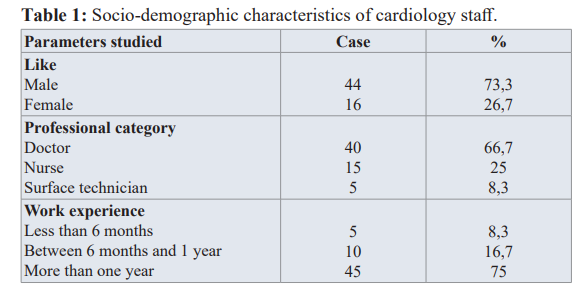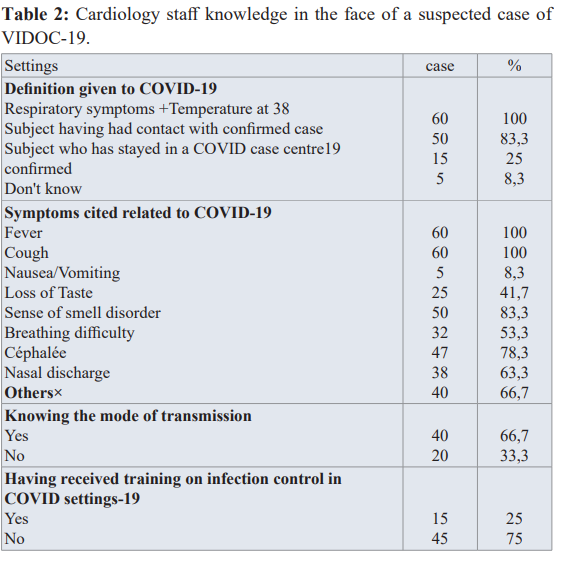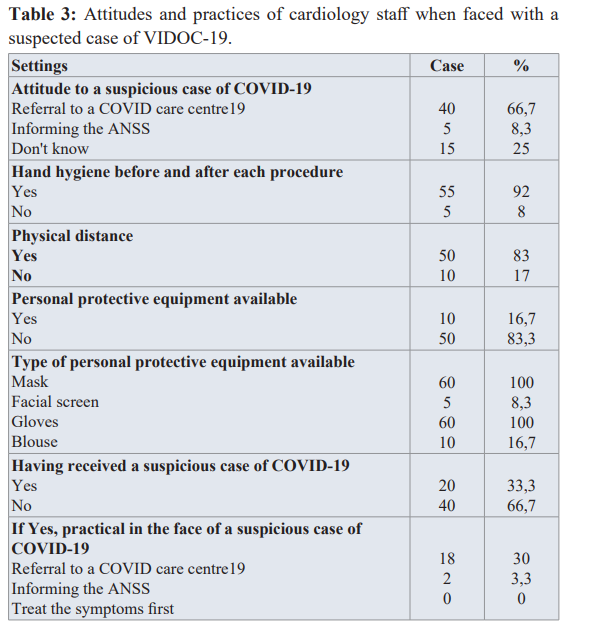Knowledge, Attitudes and Practices of Health Care Staff Related to COVID-19 in The Guinean Cardiological Environment
Author'(s): Balde Mamadou Dadhi1*, Bah Mamadou Bassirou1, Balde El hadj Yaya1, Camara Abdoulaye1, Béavogui Mariame1, Barry Ibrahima Sory1, Kone Alpha2, Balde Mamadou Aliou1, Sylla Ibrahima Sory1, Diakité Souleymane3, Diallo Mamadou1, Diallo Mamadou Madiou1, Balde Aissatou Tiguidanke1 and Conde Mamady1
1Cardiology Department of the Ignace Deen National Hospital CHU in Conakry, Republic of Guinea.
2Cardiology Department of Donka National Hospital, Republic of Guinea.
3Cardiology service, army health service.
*Correspondence:
Baldé Mamadou Dadhi, Cardiology Department of the Ignace Deen National Hospital CHU in Conakry, Republic of Guinea.
Received: 18 February 2021; Accepted: 11 March 2021
Citation: Dadhi BM, Bassirou BM, El hadj Yaya B, et al. Knowledge, Attitudes and Practices of Health Care Staff Related to COVID-19 in The Guinean Cardiological Environment. Cardiol Vasc Res. 2021; 5(2): 1-3.
Abstract
The objective of this study was to assess the level of knowledge, attitude and practices of the staff of the cardiology department Ignace Deen in the face of a suspected case of COVID-19 infection. The SARS-CoV-2 coronavirus epidemic is responsible for very high morbidity in the world. The World Health Organization classifies it as a public health emergency. Guinea, through the National Health Security Agency (ANSS) recorded its first case of COVID-19 infection on March 12, 2020. Since the country has known 6,141 cases, including 37 cases of death among which are the staff health. The surveys were carried out at the cardiology department of the Ignace Deen National Hospital among all professional categories of the department. Health professionals included doctors, nurses and surface technicians (boys and girls in the ward).We conducted an analytical cross-sectional study that ran from June 1 to 30, 2020. During our study, 60 participants answered our questions. The average age of our participants was 33.5 ± 5 years with the extremes of 25 and 66 years old. The male gender predominated in this study, i.e. 73.7% against 26.3% of the female gender. Doctors were the most represented professional category, i.e. 66.7%, followed by nurses 25% and surface technicians with 8.3%. Our result corroborates the study carried out by Usman Rashid Malik et al. in Pakistan, doctors and nurses were the most represented health workers, at 37.4% and 29.4% respectively. Faced with this pandemic, of which no one knows the outcome, particular emphasis must be placed on training in the prevention and control of infections for staff, which is one of the strong links in the fight against this pandemic and the availability of personal protective equipment.
Keywords
Introduction
The SARS-CoV-2 coronavirus epidemic is responsible for very high morbidity worldwide. It is classified as a public health emergency by the World Health Organization [1]. COVID-19 has been identified as a new and contagious primary atypical (viral) pneumonia that has been reported to have caused similar clusters of outbreaks to the Severe Acute Respiratory Syndrome Coronavirus (SARS-CoV) and the Middle East Respiratory
Syndrome Coronavirus (MERS-CoV) [2,3]. The most common clinical signs are fever, cough, acute respiratory distress, decreased or normal white blood cells, fatigue and inability to resolve within 3-5 days of antibiotic treatment [4]. The World Health Organization (WHO) declared the emerging coronavirus 2019 (COVID-19) disease an international public health emergency on 30 January 2020 [5]. In that the COVID-19 epidemic was unique in terms of high pathogenicity and mortality compared to previous coronavirus epidemics [6-8]. Guinea, through the national health security agency (ANSS), registered its first case of COVID-19 infection on 12 March 2020. Since then, the country has seen 6141 positive cases including 37 cases of death among which are health workers [9]. Healthcare workers are essential workers defined as paid and unpaid persons working in healthcare facilities who may be exposed directly or indirectly to patients or infectious substances [10]. As healthcare workers are exposed to healthcare- associated infections, the scarcity of available data on this subject has led to the objective of this study, which was to assess the level of knowledge, attitude and practices of the staff of the Ignace Deen cardiology department in the face of a suspected case of COVID-19 infection.
Materials and Methods
The surveys were carried out at the Cardiology Department of the Ignace Deen National Hospital, and covered all professional categories in the department. The health professionals included doctors, nurses and surface technicians (ward boys and girls).
We conducted an analytical cross-sectional study which ran from June 1 to June 30, 2020, and the study population consisted of the staff of the cardiology department.
The information collected concerned the socio-demographic characteristics of the providers (age, sex, position, length of time in the current position), their knowledge of suspected cases of COVID-19 (symptoms, identification of a suspected case of COVID-19, whether or not they had received training in infection prevention in the context of COVID-19), their attitudes and practices when faced with a suspected case of COVID-19 received in the department, the personal protective equipment available and the behaviour adopted when faced with suspected cases of COVID-19.The data was doubly captured and then analysed using EPI Info 7.1.5 software. Free and informed consent was obtained from each participant before the questionnaire was administered.
Results
During our study, 60 participants answered our questions. Table 1 shows the socio-demographic characteristics of the nursing staff in the cardiology department. The average age of our participants was 33.5 ± 5 years with the extremes of 25 and 66 years. The male gender predominated in this study, i.e. 73.7% compared to 26.3% of the female gender. In table 2, staff knowledge is described. Table 3 shows the attitudes and practices of the staff when faced with a suspected case of COVID-19.



Discussion
During our study, 60 participants out of 70 staff members answered our questions, a participation rate of 86%. This high rate of participation in this survey could be explained by the fact that the COVID-19 pandemic has created a great deal of interest among healthcare personnel in order to assess their level of knowledge, their attitude and their practices when faced with a suspected case of COVID-19 in order to better protect themselves. The average age of our participants was 33.5 ± 5 years with the extremes of 25 and 66 years. The male gender predominated in this study, i.e. 73.7% compared to 26.3% of the female gender.
Doctors were the most represented professional category with 66.7%, followed by nurses with 25% and surface technicians with 8.3%. Our result corroborates that in the study conducted by Usman Rashid Malik et al [11] in Pakistan, doctors and nurses were the most represented health care workers with 37.4% and 29.4% respectively.
This study, the first of its kind at the Ignace Deen Cardiology Department, shows a good level of knowledge of COVID-19. On the other hand, many studies have shown a low level of knowledge by the nursing staff, as is the case in Egypt, Iran and Greece [12,13,14]. During our study, only one confirmed case of COVID-19 was recorded in the Ignace Deen cardiology department, i.e. 1.4%, thus justifying the very low contagion rate of its staff, unlike in China, where 2050 cases of COVID-19 were reported among healthcare workers on 20 February 2020; the majority of cases were due to a lower level of knowledge and experience in managing the disease [15].
The present study shows that the vast majority had a good attitude and practice when faced with a suspected case of COVID-19 because hand hygiene was carried out by 92%, wearing masks was systematic by 100% and physical distancing was respected by 83% of the staff. The same observation was made [11] in Pakistan. Unlike in Greece, where only 1 in 4 health professionals had a hand washing routine before and after interaction with the patient [13]. Thus good knowledge of the disease has a far-reaching influence on the attitudes and practices of health care staff, as our result illustrates.
The majority of staff who received a suspicious case referred to a COVID-19 management centre or informed the National Health Security Agency. In addition, staff did not have sufficient personal protective equipment available.
Conclusion
This study allowed us to assess the level of knowledge, attitudes and practices of cardiology staff in the context of the COVID-19 pandemic. In the face of this pandemic, the outcome of which is unknown, particular emphasis must be placed on the infection prevention and control training of personnel, which is one of the strong links in the fight against this pandemic, and the availability of personal protective equipment.
References
- World Health Organization. Coronavirus disease. 2019 (COVID-19). Situation Report 32. 2020.
- Huang C, Wang Y, Li X, et al. Clinical characteristics of patients infected with the new coronavirus 2019 in Wuhan, China. Lancet. 2020; 395: 497-506.
- Liu Y, Gayle AA, Wilder-Smith A, et al. The reproductive number of COVID-19 is higher compared to SARS coronavirus. J Travel Med. 2020; 27.
- Lake MA. What we know so far: Current clinical knowledge and research on COVID-19. Clin Med. 2020; 20: 124-127.
- World Health Organization (WHO). Statement on the second meeting of the Emergency Committee of the International Health Regulations (2005) concerning the outbreak of a new coronavirus (COVID-19). WHO. 2020.
- Zhao D, Yao F, Wang L, et al. A comparative study on the clinical features of COVID-19 pneumonia to other pneumonias. Clin Infect Dis. 2020; ciaa247.
- Hossain MM. Current state of global research on the emerging coronavirus disease (COVID-19): bibliometric analysis and knowledge mapping. SSRN Electronic Journal. 2020.
- WHO. Report of the Joint WHO-China Mission on Coronavirus Disease 2019 (COVID-19). WHO. 2020.
- National Health Security Agency, communication from the Director General 13 July 2020 Guinea/Health COVID-19. Consulted on 20 August 2020 at 23:10.
- US Department of Homeland Security. Advisory memorandum on identification of essential critical infrastructure workers during COVID-19 response. Washington, DC: US Department of Homeland Security. 2020.
- Usman Rashid Malik, Naveel Atif, Furqan Khurshid Hashmi, et al. Knowledge, Attitude, and Practices of Healthcare Professionals on COVID-19 and Risk Assessment to Prevent the Epidemic Spread: A Multicenter Cross-Sectional Study from Punjab, Pakistan. Int J Environ Res Public Health. 2020; 17: 639512.
- Abdel-Wahed WY, Hefzy EM, Ahmed MI, et al. Assessment of Knowledge, Attitudes, and Perception of Health Care Workers Concerning COVID-19, A Cross-Sectional Study from Egypt. J Commun Health. 2020 ; 1-10.
- Papagiannis D, Malli F, Raptis DG, et al. Assessment of knowledge, attitudes and practices towards the new coronavirus (SARS-CoV-2) of health professionals in Greece before the epidemic period. Int J Environ Res Public Health. 2020; 17: 4925.
- Taghrir MH, Borazjani R, Shiraly R. COVID-19 and Iranian medical students; A survey of their related knowledge, preventive behaviour and risk perception. Cambre Iran Med. 2020; 23 : 249-254.
- World Health Organization (WHO). Report of the Joint WHO- China Mission on Coronavirus Disease 2019 (COVID-19). 2019. Available online: https://www.who.int/publications-detail/report-of-the-who-china-joint-mission-on-coronavirus-disease-2019-(COVID-19)(accessed15August2020).